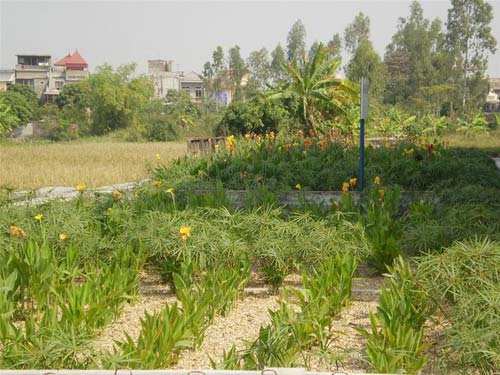Clean toxic waste with microorganisms
The DEWATS model at Kim Bang Hospital - Ha Nam is a model for dispersing waste water through the use of microorganisms in wastewater or natural processes, without using chemicals. This is a high-tech, low-cost process that still ensures the quality of outlet wastewater is up to standard.
Mr. Vu Dinh Phung - Director of Kim Bang General Hospital (Ha Nam), said: With a capacity of 250 beds, the hospital often has to operate in overload, at the peak rate using sick beds up to 250%. This leads to the situation that all wastewater of toilets and bathrooms, medical examination and treatment areas are discharged directly into the environment under the infiltration mechanism, the rest has not been absorbed yet to the surrounding fields. .
In addition, waste water from the subclinical examination site containing hazardous chemicals from radiology rooms and laboratories is not properly collected but discharged directly into the environment.
Contaminants in wastewater cause bioaccumulation in fish and plants and seriously affect the area's habitat, making it a ' hot spot ' of pollution in the province.
After conducting field research, experts from the Bremen Research and Development Association (BORDA) - a German non-governmental organization - noticed, the wastewater of Kim Bang General Hospital has the same characteristics as Domestic wastewater with high organic pollution content and can be completely treated by biotechnology.
'After the survey, we decided to choose Kim Bang General Hospital, a rather prominent area for wastewater sanitation as a place to pilot DEWATS. Distributed sewage treatment system allows the treatment of organic wastewater with a scale of less than 1,000m 3 / day and night with the advantage of high treatment efficiency, can adapt to fluctuations in flow, no need Power consumption (if the treatment area has appropriate slope).
Environment-friendly treatment technology, treating wastewater by microorganisms in waste water or natural processes without using chemicals' - Mr. Lutz R.Meyer - Director of BORDA Mekong Region , China said.

Plant filter area in DEWATS system (Photo: TP)
After many meetings, in December 2006, the first DEWATS system in Vietnam started construction at Kim Bang General Hospital (Kim Bang, Ha Nam) with a capacity of 125m 3 / day and night.
The entire investment cost of VND 720 million was originally built by the German Ministry of Economic Development Cooperation. The hospital only has to pay rent to take care of underground purification plant and remove algae to clean the indicator pond.
Results of water quality testing after being treated with DEWATS show that waste water after filtering helps bacteria to 95 - 97%, BOD (biochemical oxygen demand) index reaches 4mg / liter (standard of the Ministry of Health is 20), COD (biological oxygen demand) is 16mg / liter (the Ministry of Health's standard for hospitals is 80).
'In the past, the hospital used the usual way of treating wastewater, digging self-infiltration tanks, causing serious environmental pollution. The investment in this old-style wastewater treatment system takes more than 3 billion VND and the monthly operating cost is up to 20-30 million VND. The test results show that water is treated with DEWATS completely 'clean' and meets the Ministry of Health's regulations on waste water ' - Mr. Vu Dinh Phung - Director of Kim Bang Hospital is excited.
The DEWATS model at Kim Bang Hospital marked a turning point in solving pollution by organic waste with low cost, which is now being paid attention by many units.
Currently DEWATS is in the process of building a system at Tam Dao Bear Rescue Center and is about to deploy at Thanh Hoa Children's Hospital.
DEWATS has been present in many countries around the world such as India, Indonesia, Ethiopia, and China since 1977. However, it is not until recently that this superior system has been applied in Vietnam.
DEWATS uses microbiology technology, through four main stages.The first stage of preliminary treatment is the sedimentation process to remove suspended sediments through the baffle anaerobic reactor tank.
Second stage, suspended solids and dissolved in waste water are removed by aerobic microorganisms through anaerobic filtration tank and anaerobic sedimentation tank.The wastewater will then be transferred to the aerobic treatment stage through the Plant Filter Area and finally disinfected in the indicator pond.
Linh Nga - Pham Tuyen
- Hazardous waste can cause bisexual syndrome in polar bears
- Technology turns waste into non-toxic glass
- Clean water and numbers to speak
- Techniques of raising clean meat with yeast for microbiology
- Big break: Recyclable plastic waste will be turned into super clean electricity
- Technology to turn toxic waste into energy
- 'Pin' lives in the deep sea
- Donation and transplantation of human waste in medicine - jokes but 100% true chemistry
- Method to turn astronaut waste into food
- Spill on marine fish contaminated with toxic plastic
- Electric waste like global time bomb
- Too clean water is harmful
 'Barefoot engineer' invents a pipeless pump
'Barefoot engineer' invents a pipeless pump Process of handling dead pigs due to disease
Process of handling dead pigs due to disease Radiometer
Radiometer Warp Engine: Technology brings us closer to the speed of light
Warp Engine: Technology brings us closer to the speed of light